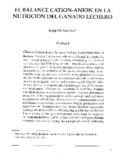Mostrar el registro sencillo del ítem
El balance catión-anión en la nutrición del ganado lechero
| dc.creator | Sánchez González, Jorge Manuel | |
| dc.date.accessioned | 2015-05-28T15:06:28Z | |
| dc.date.available | 2015-05-28T15:06:28Z | |
| dc.date.issued | 2013-07-18 00:00:00 | |
| dc.identifier.citation | http://revistas.ucr.ac.cr/index.php/nutrianimal/article/view/10721 | |
| dc.identifier.issn | ||
| dc.identifier.uri | https://hdl.handle.net/10669/13502 | |
| dc.description.abstract | Dietary Cation-Anion Balance in Dairy Cattle Nutrition. AReview. Dietary Cation-Anion Balance (DCAB) is a relativelynew concept in Dairy Cattle nutrition and feeding. it is definedas mEq (Na+K)-(Cl+S)/kg of DM. Metabolic acidosis andalkalosis is given by blood protein concentration and byinorganic ions absorbed from the gastrointestinal tract. If weconsider blood protein concentration to be relatively constant,the metabolic acid-base balance of blood and cells is attributedmainly to inorganic cations and anions supplied by the diet.Anions have an acidogenic effect in the organism, while cationsare alkalogenic. Changes in the metabolic acid-base balancecan affect celular enzyme activity and the structure of hormonereceptors, reducing production of the animals and resistanceto metabolic imbalances. However, technical manipulation ofthis balance can contribute to improve health, production andreproduction. Several studies have found that feeding anionic(acidogenic diets) (-100 to -200 mEq/kg of DM) during the last3 to 4 weeks of the gestation period contribute to improvecalcium metabolism and to reduce the level of hypocalcemianormally occurring during the puerperal period, reducing incidence of milk fever and other problems such as retentionof fetal membranes.Also, it has been observed that cows fedthese diets improved milk production in 3 to 7% during thenext lactation, as well as reproduction. About the best DCABto be fed during the lactation period, it has been found thatalkalogenic diets are better for milk production. Some workershave found the best milk production and DM intake feedingdiets with a DCAB of +300 to +500 mEq/kg of DM (calculatedas (Na+K-CI)). Acidogenic salts usually used to feed dry cowsare Calcium Sulfate, Magnesium Sulfate, Ammonium Sulfate,Calcium Cloride, Magnesium Cloride and Ammonium Cloride.Palatability of these salts is low. Diets betvveen -100 to -200mEq/kg of DM have given the best results to reduce incidenceof milk fever. These acidogenic rations should supply between140 and 150 g of calcium per cow per day and must be fed atleast during 10 days prepartum. | |
| dc.format.extent | - | |
| dc.relation.ispartof | Nutrición Animal Tropical Vol. 2 Núm. 1 | |
| dc.subject | fiebre de leche | |
| dc.subject | balance catión-anión | |
| dc.subject | ganado | |
| dc.title | El balance catión-anión en la nutrición del ganado lechero | |
| dc.type | artículo original | |
| dc.date.updated | 2015-05-28T15:06:28Z | |
| dc.language.rfc3066 | es |


